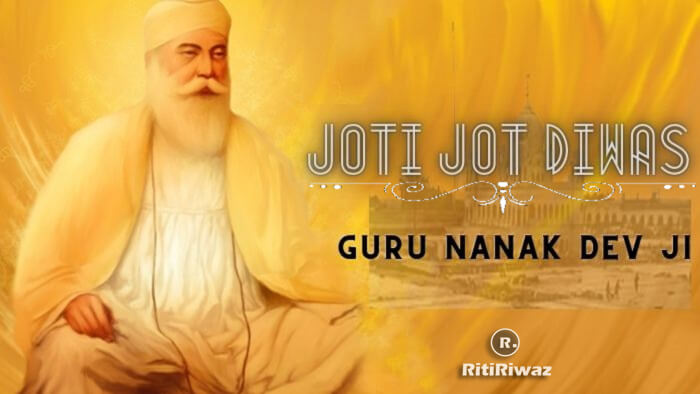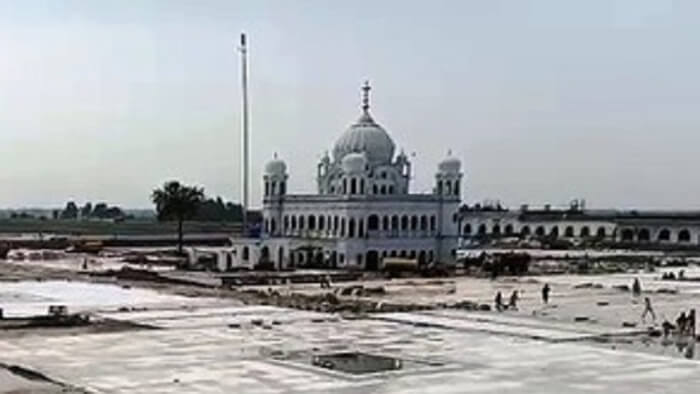Joti Jot and the Guru Nanak Dev

Joti Jot means “immersed in the Eternal Light”, according to Guru’s and holy Sikh scriptures when someone immortal leaves his existence they have not died but rejoined with God and this is called Joti Jot. Guru Nanak is believed to have died at Kartarpur on September 22, 1539, and is termed as Guru Nanak Dev’s Joti Jot.
Guru Nanak Dev’s Joti Jot
Guru Nanak after his mission tours he finally settled in Kartarpur until the end of his days, by that time he was widely known and respected for his humanity and service. Many of his followers were Hindu and Muslim who claimed him to be their Guru.
One day Guru Nanak told Bhai Sadharan that his end is nearing on Asu 10. 1596 Bik, he declared Bhai Lehna as his successor. He renamed Bhai Lehna as Guru Angad, meaning “one’s very own” or “part of you”. Guru’s sons and family vehemently opposed Guru’s decision and were even conspiring to beat and expel Guru Angad from Kartarpur. Guru Nanak, therefore, advised Guru Angad to leave Kartarpur for Khadoor sahib.
Shortly after proclaiming Bhai Lehna as his successor, Guru Nanak died on 22 September 1539 in Kartarpur, at the age of 70. This news spread like a wildfire and people start gathering at Kartarpur Sahib. There was a terrible controversy between his Hindu and Muslim disciples. The Hindus said he had to be cremated and the Muslims said that he had to be buried.
A Faqir gave the solution to the dispute. In accordance with the Indian tradition, the dead body had been covered with a piece of cloth. The faqir advised the Hindus and Muslims to keep flowers on the body of Guru Nanak under the cloth and in the next morning check whose flowers.
Whosoever’s flowers were found withered the next morning would lose the claim. In the morning when they removed the cloth and everyone was amazed to see that the dead body had completely disappeared! In its place were hundreds of beautiful, fragrant flowers. So the two communities decided to divide the cloth sheet and flowers in half. Hindus and the Muslims each took half of the flowers, the Muslims bury them, and Hindus consigned them to fire.
Therefore, both a samadhi (Hindu tradition monument of remembrance) lies in the Gurdwara at Kartarpur and a grave (according to Muslim traditions) lies on the premises as a reminder of this joint claim to Guru Nanak Dev Ji by both the communities. The grave is outside the Kartarpur building. Guru Nanak is considered to have departed his body only while his jot is immortal and passed through each succeeding Gurus and now forever resides in Guru Granth Sahib.
The Kartarpur Corridor

Gurdwara Kartarpur Sahib, considered the holiest place in the Sikh religion because it is the last resting place of Baba Guru Nanak, which is located in Narowal, only 4 kilometers away from the Indian border. The shrine is visible from the Indian side of the border and every day a larger number of Sikh devotees gather to perform Darshan or sacred viewings of the site. Daily thousands of people visit the Corridor site and have a glimpse of Kartarpur from a distance while 2.5 million people visit Corridor Point on Border between March 1 to 15 every year. John McDonald ex- UN member and peacemaker visited the Corridor site on June 20, 2008, and emphasized that this Corridor holds key to Indo-Pak peace.
On the demand of Sikhs, the Kartarpur Corridor was opened by Pakistani Prime Minister Imran Khan on 9 November 2019, the anniversary of the fall of the Berlin Wall and just days before the 550th birth anniversary of Guru Nanak. This corridor allowed Indian Sikh pilgrims rare visa-free access to the site in Pakistan. Darbar Sahib, Kartarpur is believed to be where the founder of Sikhism, Guru Nanak, lived and died at the start of the 16th century. It was the first time since the partition (when British India was divided into two states of India and Pakistan) that pilgrims have been able to travel from Dera Baba Nana shrine in northwest India’s Gurdaspur to Gurdwara Darbar Sahib in Kartarpur, Pakistan.
